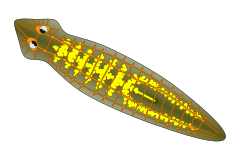Gastrovascular cavity
The gastrovascular cavity is the primary organ of digestion and circulation in two major animal phyla: the Cnidaria (including jellyfish and corals) and Platyhelminthes (flatworms). The cavity may be extensively branched into a system of canals. In cnidarians, the gastrovascular system is also known as the coelenteron, and is commonly known as a "blind gut" or "blind sac", since food enters and waste exits through the same orifice.
The radially symmetrical cnidarians have a sac-like body in two distinct layers, the epidermis and gastrodermis, with a jellylike layer called the mesoglea between. Extracellular digestion takes place within the central cavity of the sac-like body. This cavity has only one opening to the outside which, in most cnidarians, is surrounded by tentacles for capturing prey.
References
- Scott, Thomas A. (1996). Concise Encyclopedia Biology. Walter de Gruyter. pp. 376–379. ISBN 3110889560.
- Slobodkin, Lawrence; Bossert, Patricia (2010). "Cnidaria". In Thorp, James H.; Covich, Alan P. (eds.). Ecology and Classification of North American Freshwater Invertebrates (3rd ed.). Amsterdam: Academic Press. pp. 125–142. ISBN 9780123748553.


